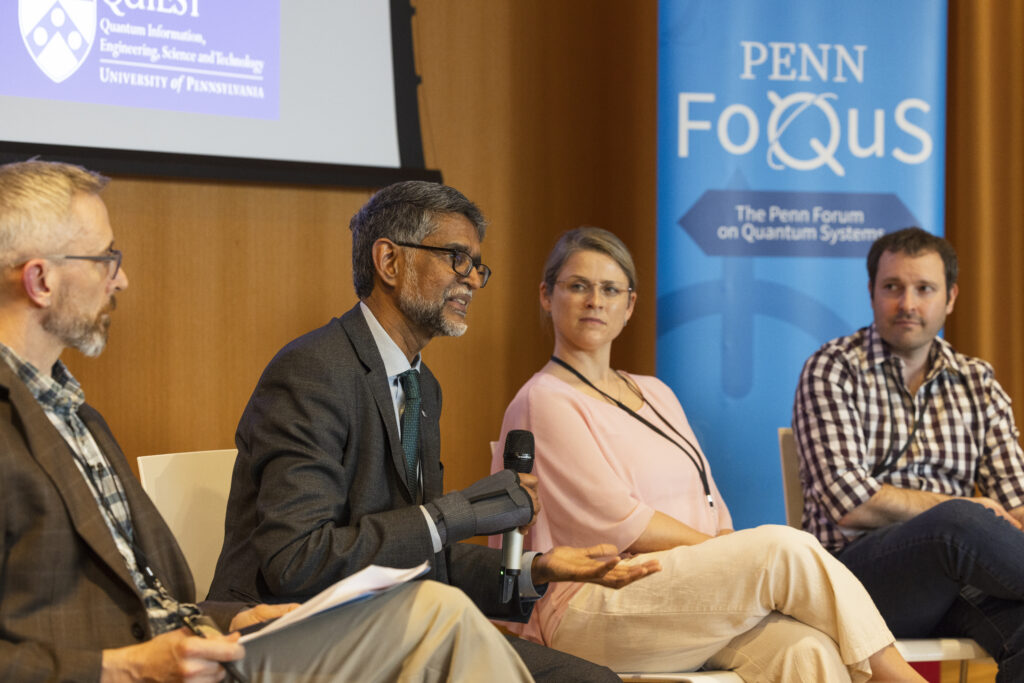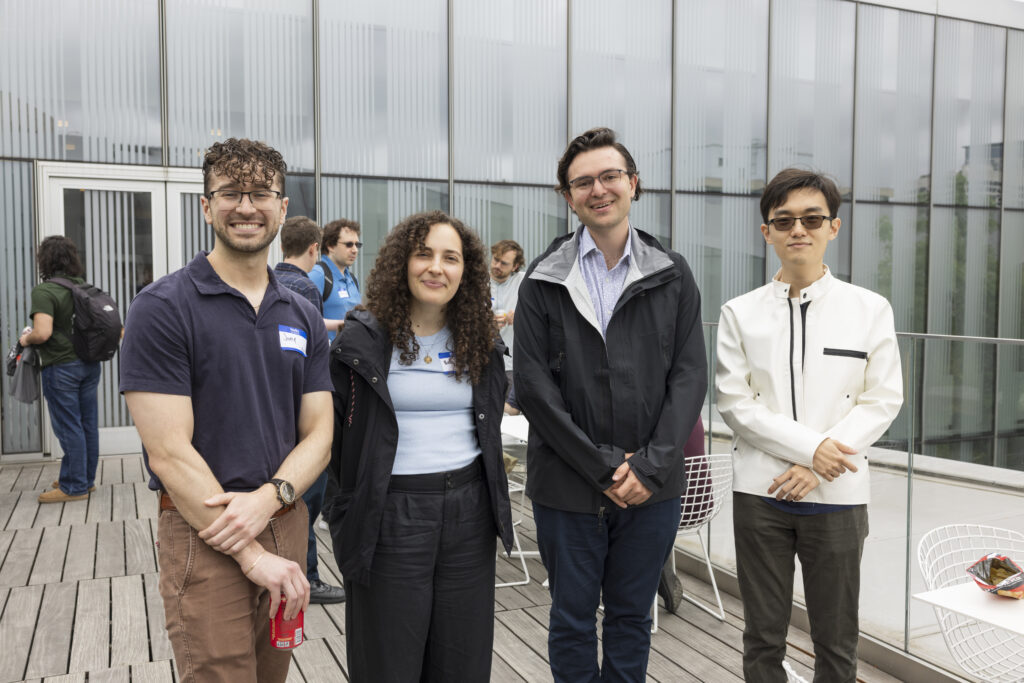The second annual Penn Forum on Quantum Systems (Penn FoQuS 2025), an event organized by the Penn Center for Quantum Information, Engineering, Science and Technology (QUIEST), welcomed thought leaders from academia, government and industry research labs, joining over 100 students, 30 faculty and 13 scientists and quantum industry professionals on May 5 and 6 to explore the transformative potential of quantum science.
As a collaborative initiative, QUIEST brings researchers from Penn Engineering and Penn Arts & Sciences together in this field. The FoQuS symposium extends this multidisciplinary effort beyond academia and into industry and government, allowing the new ideas and breakthroughs at the cutting edge of quantum research to reach a wider audience.
“Events like this are essential to building connections between people working in different areas of quantum information, and between students and researchers working in different institutions,” says Lee Bassett, Associate Professor in Electrical and Systems Engineering (ESE) and Director of QUIEST. “It’s amazing to see the growth of vibrant research in quantum information science at Penn over just the past few years.”
A panel discussion with Vijay Kumar, Nemirovsky Family Dean of Penn Engineering and Professor in Mechanical Engineering and Applied Mechanics (MEAM), Yuval Baum (of the software company Q-CTRL), Justyna Zwolak (from the National Institute of Standards and Technology) and Ryan Hadt (of Caltech) spanned a wide range of timely and thought-provoking topics, including the current landscape of funding in quantum research, recent breakthroughs and milestones, and what lies ahead for the future of the field.

Research presented at the symposium covered quantum sensing and metrology, quantum photonics, magnetic materials, computational chemistry and even the education and outreach of quantum information sciences. The diverse research topics and the mix of professional backgrounds allowed for an engaging event fit for audiences of all career levels and interests.
A few of the speakers and their presentations are described below. For a full list, visit the FoQuS event page.
Victor Acosta (University of New Mexico)Precision measurement and spectroscopy with diamond NV centers
Acosta highlighted the sensitivity of nitrogen-vacancy centers in diamond for quantum sensing. His research pushes the boundaries of precision measurement, with applications from materials characterization to magnetic field detection.
Matthew Doty (University of Delaware)Toward scalable nanophotonic devices exploiting InAs QDs
Doty presented developments in tiny devices, called quantum dots, that can reliably produce single particles of light, one at a time, which are vital for scalable photonic quantum technologies. His team is working on ways to manufacture these devices in a highly controlled and predictable way, across large surfaces such as computer chips.
Yuval Baum (Q-CTRL)Transforming the path to quantum advantage with quantum software
From quantum chemistry to optimization, Baum showcased how Q-CTRL’s software enhances quantum algorithm performance. He showed how their tools improve the way quantum algorithms work, especially in areas like chemistry and problem solving. Even though fully reliable (fault-tolerant) quantum computers are still years away, this software is helping unlock real-world benefits much sooner than expected.
Xuemei Cheng (Bryn Mawr College)Magnetic skyrmions for information storage and quantum computing
Cheng shared her work on magnetic skyrmions — tiny, swirling spin structures with quantum potential. These nanostructures could serve as innovative building blocks for quantum memory and logic devices.
Shaping the Future of Quantum
While the event leads with an impressive array of professionals established in their work, it also prioritized the audience that would bring quantum science into the future — students and early-career researchers.
“The QUIEST Center has been broadening its support beyond faculty to actively engage and uplift its student community, with initiatives like the biweekly student-led Quantum Seminars fostering interdisciplinary collaboration and research presentation skills,” says Marian Bechtel, Program Coordinator for QUIEST. “These efforts culminated in strong student participation at this year’s FoQuS event who were deeply involved in every aspect, from presenting and speaking to engaging in social activities. Their enthusiasm and leadership were central to the program’s success and a testament to their role in shaping the future of quantum science.”

Students’ insights into how FoQuS sets them up for success in networking, collaboration and perspective shifting in terms of career direction and research interests illustrate the need for the events and communities being built at Penn.
“The conference was a great opportunity to learn about the diverse ways in which other research groups are preparing us for a quantum technology-centric future,” says Joseph Minnella, a Ph.D. student in Physics & Astronomy at Penn’s School of Arts & Sciences.
“I felt truly immersed in the multidisciplinary quantum information science efforts at Penn,” shares Isabela Gnasso, a Ph.D. student at Virginia Tech. “The featured talks touched on uniquely important topics in the field and we had the opportunity to join lab tours that were very informative. I felt very welcome and included throughout this gathering and really got a sense of the amazing work being done at Penn. As both a speaker and poster presenter, this was certainly an opportunity for growth in a supportive environment of wonderful people and experts in our field.”
To learn more about FoQus and ways the QUIEST Center supports collaborative work and the next generation of engineers, visit their website.
by Melissa Pappas
Published on May 15, 2025 on Penn Engineering Today
